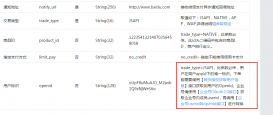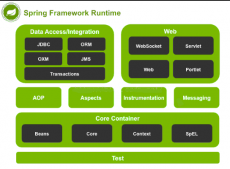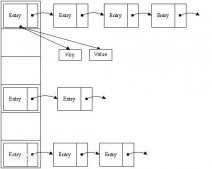Java注解作为程序元素(类、成员变量、成员方法等)的一种元数据信息,对程序本身的执行不会产生影响。通过自定义注解,可以给程序元素添加特殊的声明。
Spring作为构建企业级应用的平台,提供了丰富的功能。将Java的自定义注解与Spring结合,在特定场景下实现注解的解析、处理,可以降低应用的耦合度,提高程序的可扩展性。
2.应用场景
下面总结几种应用场景,仅说明大致思路(ps:并非所有场景都在项目中实践过)
2.1登陆、权限拦截
在web项目中,登陆拦截和权限拦截是一个老生常谈的功能。通过自定义登陆注解或权限注解,在自定义拦截器中解析注解,实现登陆和权限的拦截功能。
这种使用方式,配置简单,灵活度高,代码耦合度低。
2.2定时任务管理
在系统构建过程中,会有各种定时任务的需求,而定时任务的集中管理,可以更高效维护系统的运行。
通过Java注解官方文档RepeatingAnnotations章节中的自定义的定时任务注解,可以实现业务方法的定时任务声明。结合Spring的容器后处理器BeanPostProcessor(ps:Spring容器后处理器下篇再说),解析自定义注解。解析后的注解信息再使用QuartzAPI构建运行时定时任务,即可完成定时任务的运行时创建和集中管理。
这种方式能避免定义Quartz定时任务的配置,提高系统扩展性。
2.3多数据源路由的数据源指定
Spring提供的AbstractRoutingDataSource实现多数据源的动态路由,可应用在主从分离的架构下。通过对不同的方法指定不同的数据源,实现数据源的动态路由(例如:读方法走从库数据源,写方法走主库数据源)。而如何标识不同的方法对应的数据源类型,则可使用自定义注解实现。通过解析方法上声明的自定义注解对应的数据源类型,实现数据源的路由功能。
这种方式避免了对方法的模式匹配解析(例如:select开头、update开头等),声明更加灵活。
自定义注解
先看一个最简单的例子,在使用SpringWeb应用中的过程中,大家免不了会使用@Controller,@Service,@Repository等注解来定义JavaBean。那么怎么自己定义一个注解,Spring可以自动加载呢。所以就有了第一个例子。
|
1
2
3
4
5
6
7
|
@Target({ ElementType.TYPE })@Retention(RetentionPolicy.RUNTIME)@Documented@Componentpublic @interface MyComponent { String value() default "";} |
|
1
2
3
4
5
6
7
8
9
10
11
12
13
14
15
16
|
@Configurationpublic class ComponentAnnotationTest { public static void main(String[] args) { AnnotationConfigApplicationContext annotationConfigApplicationContext = new AnnotationConfigApplicationContext();annotationConfigApplicationContext.register(ComponentAnnotationTest.class); annotationConfigApplicationContext.refresh(); InjectClass injectClass = annotationConfigApplicationContext.getBean(InjectClass.class); injectClass.print(); } @MyComponent public static class InjectClass { public void print() { System.out.println("hello world"); } }} |
运行这个例子,就会发现,@MyComponent 注解的类,也被Spring加载进来了,而且可以当成普通的JavaBean正常的使用。查看Spring的源码会发现,Spring是使用ClassPathScanningCandidateComponentProvider扫描package,这个类有这样的注释
|
1
2
|
A component provider that scans the classpath from a base package. It then applies exclude and include filters to the resulting classes to find candidates. |
这个类的 registerDefaultFilters 方法有这样几行代码
|
1
2
3
4
5
6
7
8
9
10
11
12
13
14
15
16
17
|
protected void registerDefaultFilters() { this.includeFilters.add(new AnnotationTypeFilter(Component.class)); ClassLoader cl = ClassPathScanningCandidateComponentProvider.class.getClassLoader(); try { this.includeFilters.add(new AnnotationTypeFilter(((Class<? extends Annotation>) ClassUtils.forName("javax.annotation.ManagedBean", cl)), false)); logger.debug("JSR-250 'javax.annotation.ManagedBean' found and supported for component scanning"); } catch (ClassNotFoundException ex) { // JSR-250 1.1 API (as included in Java EE 6) not available - simply skip. } try { this.includeFilters.add(new AnnotationTypeFilter(((Class<? extends Annotation>) ClassUtils.forName("javax.inject.Named", cl)), false)); logger.debug("JSR-330 'javax.inject.Named' annotation found and supported for component scanning"); } catch (ClassNotFoundException ex) { // JSR-330 API not available - simply skip. }} |
这里就会发现Spring在扫描类信息的使用只会判断被@Component注解的类,所以任何自定义的注解只要带上@Component(当然还要有String value() default "";的方法,因为Spring的Bean都是有beanName唯一标示的),都可以被Spring扫描到,并注入容器内。
总结
以上就是本文关于浅谈自定义注解在Spring中的应用的全部内容,希望对大家有所帮助。感兴趣的朋友可以继续参阅本站其他相关专题,如有不足之处,欢迎留言指出。感谢朋友们对本站的支持!
原文链接:http://blog.csdn.net/liuxigiant/article/details/54296489














